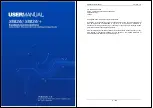
Operation Manual – Getting Started
H3C VG Series Voice Gateways
Chapter 1 Overview
1-1
Chapter 1 Overview
1.1 Introduction to Voice Gateway
H3C VG Voice Gateway (hereinafter referred to as VG), developed by Huawei-3Com
Technology Co., Ltd. (hereinafter referred to as Huawei-3Com) for industrial and SOHO
(small office/home office) users, is a new-generation access device which supports
integration of voice and fax.
VG implements the access of voice or fax signals and converts them into digital signals.
It then encapsulates these digital signals into IP packets and transfers them to IP
network via the Ethernet interfaces.
The cost-effective VG supports multiple IP telephony attributes, for example, voice over
IP (VoIP), fax over IP (FoIP), call control, resource management, maintenance and
management. It supports diversified codec types and can obtain IP address as a
Dynamic Host Configuration Protocol (DHCP) Client. .
VG uses ITU-T Recommendation H.323, high-performance DSP chips and
coding/decoding algorithm of high compression ratio. It also supports echo cancellation,
silence suppression, comfortable noise, jitter buffer. These measures, combined with
security and QoS attributes, can guarantee transmission quality of voice and fax
services over IP network.
The VG supports both normal and fast connection modes. With tunneling technology, it
achieves out-of-band transmission of DTMF (dual-tone multi-frequency) code. The VG
also provides busy tone detection, dedicated line dial, as well as some peculiar
services, including do-not-disturb, call forwarding on busy, alarm call service, group line
access, etc.
Currently VG provides Ethernet interfaces, FXS interfaces, FXO interfaces and E1VI
trunk interfaces, which can connect with common phone sets or Private Branch
Exchanges (PBX) or Local Area Network (LAN) or Wide Area Network (WAN).
A typical networking of VG is illustrated in Figure 1-1.



































